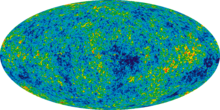
Reionization

In the field of Big Bang theory, and cosmology, reionization is the process that caused the matter in the universe to reionize after the lapse of the 'dark ages'. In the field of Big Bang theory, and cosmology, reionization is the process that caused the matter in the universe to reionize after the lapse of the 'dark ages'. Reionization is the second of two major phase transitions of gas in the universe. While the majority of baryonic matter in the universe is in the form of hydrogen and helium, reionization usually refers strictly to the reionization of hydrogen, the element. It's believed that the primordial helium also experienced the same phase of reionization changes, but at different points in the history of the universe. This is usually referred to as helium reionization. The first phase change of hydrogen in the universe was recombination, which occurred at a redshift z = 1089 (379,000 years after the Big Bang), due to the cooling of the universe to the point where the rate of recombination of electrons and protons to form neutral hydrogen was higher than the reionization rate. The universe was opaque before the recombination, due to the scattering of photons (of all wavelengths) off free electrons (and, to a significantly lesser extent, free protons), but it became increasingly transparent as more electrons and protons combined to form neutral hydrogen atoms. While the electrons of neutral hydrogen can absorb photons of some wavelengths by rising to an excited state, a universe full of neutral hydrogen will be relatively opaque only at those absorbed wavelengths, but transparent throughout most of the spectrum. The Dark Ages of the universe start at that point, because there were no light sources other than the gradually redshifting cosmic background radiation. The second phase change occurred once objects started to condense in the early universe that were energetic enough to re-ionize neutral hydrogen. As these objects formed and radiated energy, the universe reverted from being neutral, to once again being an ionized plasma. This occurred between 150 million and one billion years after the Big Bang (at a redshift 6 < z < 20). At that time, however, matter had been diffused by the expansion of the universe, and the scattering interactions of photons and electrons were much less frequent than before electron-proton recombination. Thus, the universe was full of low density ionized hydrogen and remained transparent, as is the case today.
